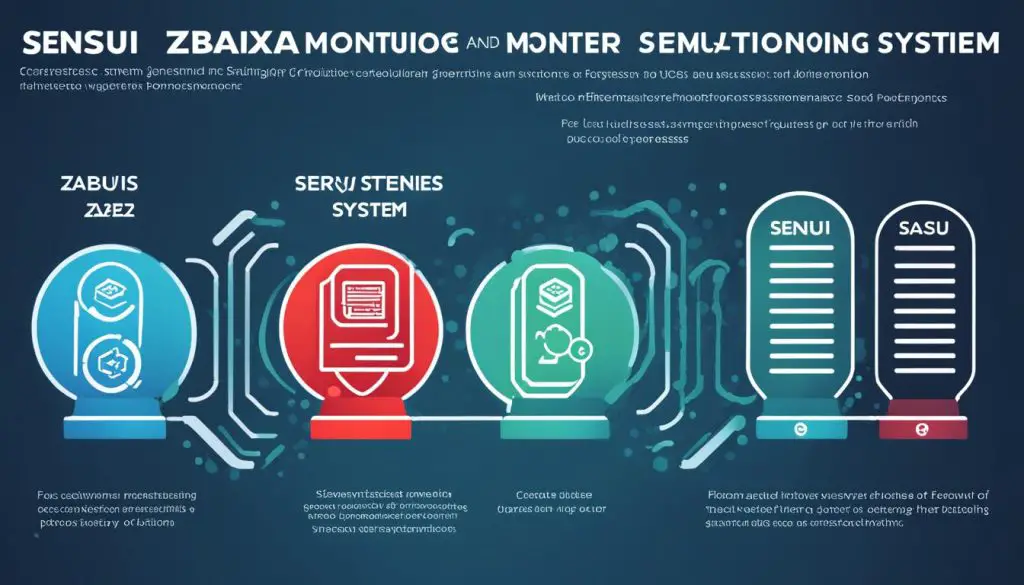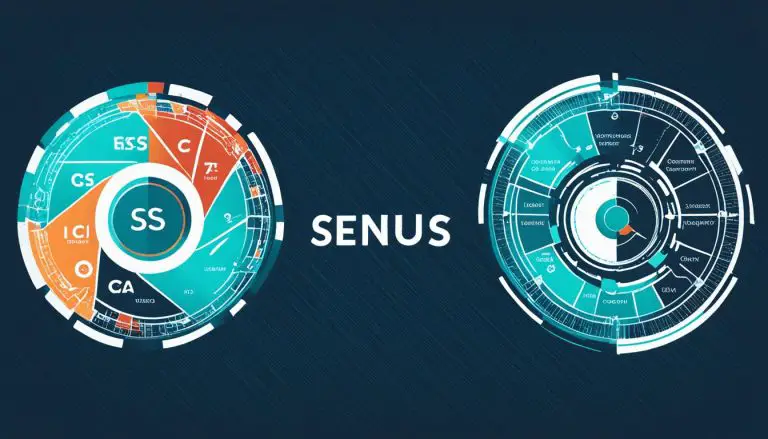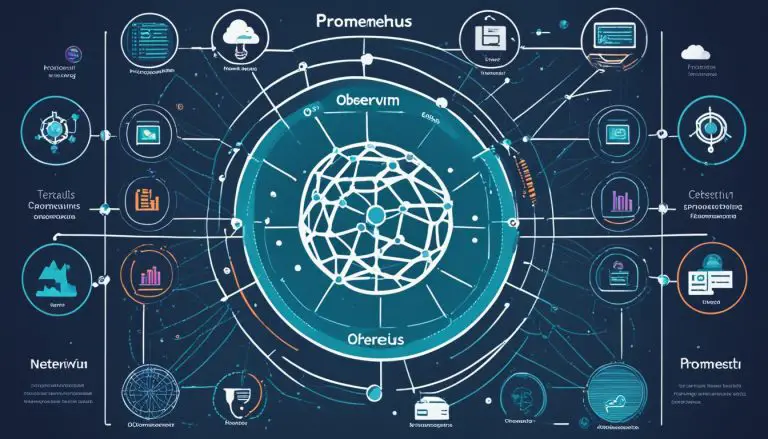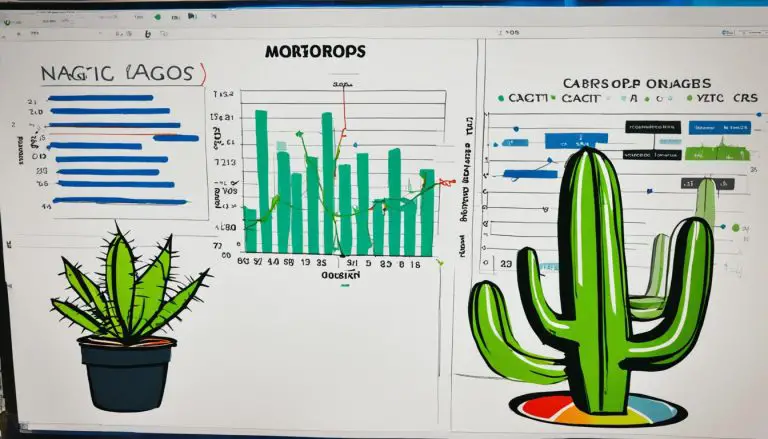Sensu vs. Zabbix: Comparing Monitoring Solutions
As organizations rely more on digital infrastructure to support their operations, the need for robust monitoring tools becomes paramount. Two popular network monitoring solutions, Sensu and Zabbix, offer powerful capabilities for infrastructure management. But what are the key feature differences between these open-source software options? And which one is better for performance analysis and maintaining an effective alerting system? Let’s delve into the details to find out.
Sensu Overview
Sensu is a powerful and versatile monitoring system designed to provide real-time visibility into the performance and health of your network and infrastructure. With its robust set of features, Sensu enables organizations to effectively monitor their systems and services, collect important metrics, evaluate rule expressions, and trigger alerts when necessary.
Sensu’s monitoring system operates by collecting metrics from configured targets. These metrics are then analyzed based on rule expressions, which allow Sensu to determine the current state of the system. This provides IT teams with valuable insights into potential issues or bottlenecks that may affect performance or availability.
One of the key strengths of Sensu is its alerting system. With customizable alert configurations, organizations can define specific conditions that will trigger alerts. This ensures that issues are promptly brought to the attention of the appropriate team members, allowing them to take proactive measures and resolve problems before they escalate.
Whether it’s monitoring the performance of servers, applications, or other components of the infrastructure, Sensu offers a comprehensive solution for capturing and analyzing metrics. It gives organizations the ability to detect anomalies and respond swiftly, preventing potential disruptions and minimizing downtime.
Sensu Benefits:
- Real-time monitoring: Sensu provides up-to-the-minute visibility into system performance and health.
- Metric collection: With Sensu, you can collect and analyze important metrics to gain insights into system behavior.
- Rule expressions: Sensu’s rule expressions enable you to define conditions for evaluating the state of your system.
- Alerting system: Sensu’s customizable alert configurations ensure that you are notified promptly of any issues or anomalies.
Overall, Sensu is a comprehensive monitoring solution that empowers organizations to monitor their network and infrastructure effectively. By collecting metrics, evaluating rule expressions, and triggering alerts, Sensu enables IT teams to maintain optimal system health and performance.
| Sensu Benefits | |
|---|---|
| Real-time monitoring | Metric collection |
| Rule expressions | Alerting system |
Zabbix Overview
Zabbix is a comprehensive host, service, and network monitoring program that offers deep visibility into servers, containers, services, applications, and functions. It provides real-time monitoring and analysis of performance metrics, enabling IT teams to swiftly identify and resolve issues for optimal system performance.
With its user-friendly interface, Zabbix simplifies the monitoring process, allowing users to easily navigate and manage their monitoring environment. The intuitive dashboard provides an overview of the network and infrastructure, giving users a clear understanding of the system’s health and performance.
Zabbix offers a range of powerful features to drive efficient monitoring. It collects performance data from various sources, including servers, virtual machines, database servers, and network devices. This deep visibility into different aspects of the infrastructure allows for comprehensive monitoring and analysis.
The flexibility of Zabbix extends to its ability to monitor diverse applications and services. Whether it’s monitoring web servers, databases, or cloud applications, Zabbix can adapt to the specific needs of an organization, making it widely applicable across different industries.
Additionally, Zabbix provides automated actions and notifications, ensuring that IT teams are promptly alerted to any anomalies or issues. These notifications can be customized based on specific conditions or metrics, allowing for proactive incident management.
“Zabbix offers deep visibility into servers, containers, applications, and functions, empowering IT teams to identify and resolve issues quickly.”
Zabbix’s extensibility is another key advantage. With a wide range of plugins and integrations, users can enhance its functionality and integrate it seamlessly with existing systems. This enables organizations to leverage their current infrastructure investments while benefiting from the robust monitoring capabilities of Zabbix.
Overall, Zabbix is a powerful monitoring solution that provides deep visibility and a user-friendly interface, making it an excellent choice for organizations seeking comprehensive host, service, and network monitoring. Its ability to monitor a wide range of systems, applications, and functions ensures that IT teams can proactively address issues and maintain optimal system performance.
| Benefits of Zabbix | Key Features |
|---|---|
|
|
Key Features of Sensu
Sensu, a leading monitoring system, offers a range of key features that make it a standout choice for network monitoring and infrastructure management. Let’s take a closer look at its key features:
Scalability
Scalability is a crucial aspect of any monitoring solution, and Sensu excels in this area. It is designed to handle the monitoring needs of large organizations, allowing IT teams to effortlessly monitor a significant number of systems and services without compromising performance or efficiency. Sensu’s scalable architecture ensures that it can keep up with the ever-growing demands of modern IT environments.
Extensibility
Sensu’s extensibility sets it apart from other monitoring systems. With its plugin architecture, users have the flexibility to add custom functionality that aligns with their specific monitoring requirements. Whether it’s integrating with proprietary tools or creating bespoke monitoring solutions, Sensu allows users to extend its capabilities and tailor the monitoring experience to their unique needs.
Automation
Automation is key to effective monitoring workflows, and Sensu delivers on this front. With Sensu, IT teams can automate various monitoring tasks, such as alerting, incident response, and remediation processes. By automating routine tasks, Sensu helps organizations streamline their operations and free up valuable resources to focus on more strategic initiatives.
Integrations
Sensu offers seamless integrations with a wide range of popular tools and technologies. This makes it a versatile choice for organizations that want to leverage their existing monitoring stack. Sensu’s integrations allow for smoother workflows, unified monitoring experiences, and enhanced visibility across the entire infrastructure.
“Sensu’s scalability, extensibility, automation, and integrations make it a powerful monitoring solution for modern IT environments.”
By combining these key features, Sensu empowers organizations to gain real-time visibility into their network and infrastructure, proactively address issues, and ensure optimal performance.
| Key Features | Description |
|---|---|
| Scalability | Monitor a large number of systems and services without compromising performance. |
| Extensibility | Add custom functionality and integrate with proprietary tools. |
| Automation | Automate monitoring workflows and streamline operations. |
| Integrations | Seamless integration with popular tools and technologies. |
With Sensu, organizations can rely on a monitoring solution that provides the scalability, extensibility, automation, and integrations needed to effectively manage their network and infrastructure.
Key Features of Zabbix
Zabbix is a highly flexible and user-friendly network monitoring solution that offers a wide range of key features to meet the diverse needs of organizations. Its powerful capabilities make it a popular choice for monitoring the performance and health of systems and services. Let’s explore some of the key features that set Zabbix apart.
Flexible Monitoring
Zabbix’s flexibility allows users to customize and tailor the monitoring process according to their specific needs. With its extensive configuration options, users can easily define parameters and thresholds for monitoring different types of systems and services. This flexibility ensures that organizations can adapt Zabbix to their unique requirements, making it a versatile tool for network monitoring.
User-Friendly Interface
One standout feature of Zabbix is its user-friendly interface, which makes it easy to navigate and configure. The intuitive design allows users to quickly access the monitoring data they need and customize dashboards to display relevant information. Zabbix’s user-friendly interface simplifies the monitoring process and enhances usability, saving time and effort for IT teams.
Monitoring Templates
Zabbix offers a wide variety of monitoring templates that provide preconfigured settings for monitoring different types of systems and services. These templates streamline the monitoring setup process, saving time and ensuring consistency across monitored environments. With Zabbix’s extensive library of templates, users can easily monitor everything from servers and network devices to applications and databases.
“Zabbix’s flexible and user-friendly features make it a popular choice for network monitoring.”
Robust Notification System
Zabbix’s notification system is designed to ensure timely alerts and notifications when issues are detected. IT teams can configure customized notification triggers based on predefined conditions, ensuring that the right people are notified when action is required. This robust notification system enables organizations to proactively address any potential problems, minimizing downtime and maximizing system performance.
Overall, Zabbix combines flexibility, user-friendliness, monitoring templates, and a robust notification system to provide organizations with a comprehensive network monitoring solution. Its powerful features empower IT teams to monitor and manage their systems effectively, enabling proactive maintenance and ensuring optimal performance.
Comparison of Sensu and Zabbix
When comparing Sensu and Zabbix, some key differences emerge. Sensu is a monitoring solution that focuses on performance analysis, providing real-time monitoring and alerting functionality. It is designed to collect metrics, evaluate rule expressions, and trigger timely alerts based on predefined conditions. With Sensu, organizations can gain valuable insights into the performance and health of their network infrastructure. This makes Sensu a valuable tool for monitoring critical systems and ensuring optimal performance of the entire IT ecosystem.
On the other hand, Zabbix offers a wider range of features that cater to infrastructure management. With Zabbix, users gain deep visibility into servers and the ability to monitor various types of systems, including host servers, virtual machines, and network devices. It provides real-time monitoring and analysis of performance metrics, allowing IT teams to identify and resolve issues quickly. Zabbix’s user-friendly interface makes it easy to navigate and manage the monitoring process, making it a popular choice among IT professionals.
“Sensu focuses on performance analysis, while Zabbix offers a wider range of features for infrastructure management.”
Both Sensu and Zabbix are open-source solutions, offering extensibility and scalability. They provide the flexibility to customize and tailor the monitoring experience according to the specific needs of the organization. However, their strengths lie in different areas based on the nature of the monitoring requirements.
Feature Differences
Here is a comparison of some key features and functionalities of Sensu and Zabbix:
| Features | Sensu | Zabbix |
|---|---|---|
| Real-time Monitoring | ✓ | ✓ |
| Alerting System | ✓ | ✓ |
| Performance Analysis | ✓ | ✗ |
| Infrastructure Management | ✗ | ✓ |
| Deep Visibility into Servers | ✗ | ✓ |
| Monitoring Virtual Machines | ✗ | ✓ |
From the comparison above, it’s evident that Sensu excels in performance analysis and real-time monitoring with its alerting system. On the other hand, Zabbix stands out in infrastructure management, providing deep visibility into servers and the ability to monitor virtual machines. Understanding these feature differences is crucial in choosing the right solution for your organization’s specific monitoring needs.

With this comprehensive comparison, organizations can make an informed decision on whether Sensu or Zabbix is the right fit for their network monitoring and infrastructure management requirements. Keeping in mind the unique strengths of each solution, organizations can align their monitoring strategies with the desired outcomes and ensure optimal performance of their IT infrastructure.
Use Cases for Sensu
Sensu is a versatile monitoring system that proves itself valuable in a variety of use cases, particularly those involving cloud infrastructure, DevOps environments, and microservices architecture.
Sensu in Cloud Infrastructure
With the increasing popularity of cloud-based solutions, businesses require monitoring systems that can scale and adapt to dynamic or hybrid cloud environments. Sensu’s scalability and extensibility make it the ideal choice for organizations relying on cloud infrastructure. Sensu can effectively monitor the performance and health of cloud environments, ensuring that resources are optimally utilized, and potential issues are identified and resolved in a timely manner.
Sensu in DevOps Environments
DevOps teams require robust monitoring tools that help them gain visibility into the entire development and deployment pipeline. Sensu’s ability to handle complex and distributed systems makes it well-suited for DevOps environments. It offers real-time visibility into the performance of applications, services, and infrastructure components, allowing DevOps teams to proactively identify bottlenecks, troubleshoot issues, and ensure smooth operations.
Sensu in Microservices Architecture
Microservices architecture has gained significant traction in recent years as a scalable and flexible approach to building complex applications. However, this architectural shift has introduced new monitoring challenges due to the distributed nature of microservices. Sensu alleviates these challenges by providing real-time visibility into the performance of individual microservices, allowing organizations to monitor the health of their entire microservices architecture. With Sensu, IT teams can quickly detect and remediate issues, ensuring that microservices run smoothly and deliver optimal performance.
Overall, Sensu’s scalability, extensibility, and ability to handle complex environments make it a valuable monitoring tool for use cases involving cloud infrastructure, DevOps environments, and microservices architecture.
Use Cases for Zabbix
Zabbix is a versatile monitoring tool that finds extensive use in infrastructure monitoring, particularly with host servers. It offers deep visibility into the underlying systems, enabling IT teams to gain comprehensive insights into their performance and health. Zabbix’s advanced features make it ideal for monitoring a wide range of infrastructure components, from physical servers to virtual machines.
The graphical user interface (GUI) of Zabbix plays a crucial role in enhancing user experience and ease of navigation. With its intuitive design, users can effortlessly configure and customize monitoring settings to cater to specific use cases and requirements. The GUI also acts as a central hub for monitoring activities, providing convenient access to critical information and enabling efficient management of monitoring workflows.
An essential feature of Zabbix is its powerful data filtering capability, allowing users to streamline the monitoring process by specifying certain criteria or patterns. This helps eliminate unnecessary noise and focus on important data points, enabling IT teams to identify performance issues more effectively and take prompt action.
Although Zabbix excels in monitoring host servers, it may have limited capabilities when it comes to monitoring virtual machines (VMs). For organizations heavily reliant on VMs, it is recommended to supplement Zabbix with specialized tools that provide more comprehensive monitoring for virtual environments.
“Zabbix’s deep visibility into host servers and intuitive GUI make it an indispensable tool for infrastructure monitoring across various use cases. Its powerful filtering capabilities ensure efficient data analysis and provide actionable insights for IT teams.”
Ultimately, Zabbix’s flexibility, user-friendly interface, and advanced features make it a valuable asset for infrastructure monitoring in a variety of scenarios.
Example Use Cases for Zabbix
- Monitoring and analyzing the performance of physical servers
- Identifying and resolving issues related to network infrastructure
- Collecting and analyzing data from connected devices and IoT devices
- Measuring response times and availability of critical applications
- Monitoring database servers to ensure optimal performance
By leveraging Zabbix’s capabilities, organizations can establish a robust monitoring system that enables proactive management, quick issue resolution, and enhanced overall performance of their infrastructure.
| Pros | Cons |
|---|---|
| Offers deep visibility into host servers | May have limited capabilities for monitoring virtual machines |
| Intuitive graphical user interface (GUI) | Requires additional tools for comprehensive VM monitoring |
| Powerful data filtering capabilities |
Comparing Support and Documentation
When it comes to support and documentation, both Sensu and Zabbix offer various resources to assist their users in optimizing their monitoring experience. Whether you need help troubleshooting an issue or exploring advanced features, both platforms have support channels in place to address your concerns.
Sensu Support
Sensu provides users with a wide range of support options. For immediate assistance, you can reach out to their dedicated phone support helpline, where knowledgeable technicians are available to guide you through any challenges you may encounter. This real-time support ensures quick resolution times and minimizes the impact on your monitoring operations.
In addition to phone support, Sensu’s online documentation serves as a valuable resource for self-help. The extensive documentation covers a range of topics, including installation, configuration, and troubleshooting. It offers detailed guides, step-by-step instructions, and best practices to help you optimize your Sensu deployment. The documentation is regularly updated, ensuring you have access to the latest information and features.
Furthermore, Sensu boasts a thriving community that actively contributes to its open-source projects. This community-driven support network allows users to seek advice, share their experiences, and collaborate on solutions. By joining the Sensu community, you gain access to a wealth of knowledge and collective expertise that can enhance your monitoring capabilities.
Zabbix Support
Zabbix has established itself as a reliable and widely-used monitoring solution, offering robust support options. Similar to Sensu, Zabbix provides users with phone support, enabling you to engage directly with their support team when you need immediate assistance. This personalized support ensures that your critical monitoring needs are addressed in a timely manner.
Moreover, Zabbix offers an abundant amount of documentation to help users navigate the complexities of the platform. The comprehensive online documentation covers everything from installation and configuration to advanced monitoring techniques. With easy-to-follow guides and in-depth explanations, this documentation serves as a valuable knowledge base for Zabbix users of all experience levels.
The Zabbix user community is another invaluable resource for support and collaboration. With a large user base, forums, and mailing lists, the community provides a platform for users to exchange ideas, share best practices, and seek guidance from fellow Zabbix enthusiasts. By leveraging the collective wisdom of the community, you can further enhance your Zabbix monitoring environment.
Now let’s compare the support and documentation features of Sensu and Zabbix in a table:
| Support and Documentation Features | Sensu | Zabbix |
|---|---|---|
| Phone Support | Available | Available |
| Online Documentation | Extensive and regularly updated | Comprehensive and user-friendly |
| Community Support | Active and collaborative community | Large user base and forums |
As you can see, both Sensu and Zabbix offer excellent support options, including phone support and extensive documentation. Sensu’s growing community of users provides an additional layer of collaboration and knowledge-sharing, while Zabbix’s established user base ensures a wealth of user-driven resources. Whether you prefer the vibrant community support of Sensu or the extensive documentation and user base of Zabbix, both platforms are committed to helping you succeed in your monitoring endeavors.
Conclusion
In conclusion, Sensu and Zabbix are both powerful monitoring solutions for network monitoring and infrastructure management. They offer robust features and capabilities to ensure the performance and health of your systems. Sensu excels in real-time monitoring and alerting, with a strong focus on performance analysis. With Sensu, you can proactively address any issues that may arise, ensuring optimal performance for your network and infrastructure.
Zabbix, on the other hand, provides deep visibility into servers and is well-suited for infrastructure monitoring. Its user-friendly interface allows for easy navigation and configuration, making it a valuable tool for monitoring various use cases. Zabbix’s strength lies in its ability to monitor different types of systems, providing comprehensive insights into your infrastructure’s performance.
The choice between Sensu and Zabbix ultimately depends on your specific needs and use cases. Whether you prioritize real-time monitoring and performance analysis or deep visibility and infrastructure management, both solutions offer reliable options. Consider your organization’s requirements, goals, and the complexity of your systems to make an informed decision. Whichever solution you choose, Sensu and Zabbix will help you optimize your network monitoring and infrastructure management for peak performance.
FAQ
What is Sensu?
What is Zabbix?
What are the key features of Sensu?
What are the key features of Zabbix?
How do Sensu and Zabbix compare?
What are the use cases for Sensu?
What are the use cases for Zabbix?
What support options are available for Sensu and Zabbix?
What is the conclusion of the comparison between Sensu and Zabbix?
Source Links
- https://stackshare.io/stackups/sensu-vs-zabbix
- https://sourceforge.net/software/compare/Sensu-vs-Zabbix/
- https://www.trustradius.com/compare-products/sensu-vs-zabbix
- About the Author
- Latest Posts
Mark is a senior content editor at Text-Center.com and has more than 20 years of experience with linux and windows operating systems. He also writes for Biteno.com






